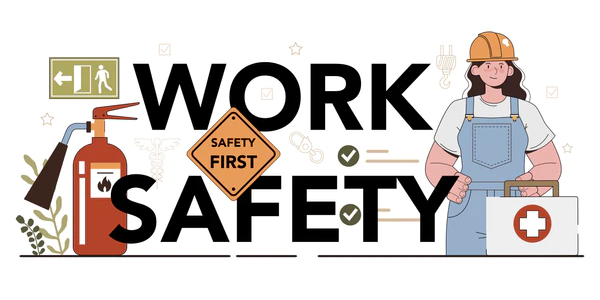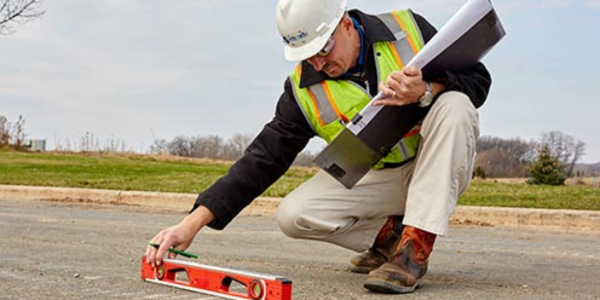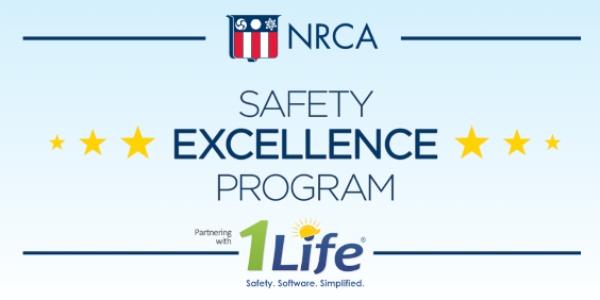5 common OSHA citations and strategies for successful compliance

By Wryker Construction Supply.
Protect your people and your business using these strategies to ensure your job site is complying with OSHA regulations.
Embracing a culture of safety is not only crucial because it keeps your employees happy and healthy, but also keeps your business safe legally. Violations of the OSHA standards for fall protection and ladder safety include over 80% of total citations and nearly 50% of any financial costs due to noncompliance in the industry. The other most common citations are for scaffolding general requirements, fall protection training requirements and eye and face protection. Make sure to check and update your company’s safety program after learning about prevention strategies from the experts at Wryker.
1 - Duty to have fall protection (Standard: §1926.0501)
This is the most frequently cited OSHA standard in construction. With over 6200 instances reported between October 2021 and September 2022, it more than doubles the number of citations attributed to Ladder Safety. Clearly there is room for our industry to grow and improve here.
When appropriate fall protection materials are supplied, the risk of serious harm or death to the workforce drops dramatically. There are strong financial repercussions for companies who do not adhere to this standard, reaching far beyond the cost of providing appropriate gear to employees. Fall protection is an investment that employers can't afford to put off - for the safety of their workforce or for the company's ability to stay in business.
1926.0501(a) articulates that employers are required to determine when fall protection is necessary and to provide fall protection that conforms to all relevant standards when it is.
1926.0501(b) provides detail about fall protection requirements for Leading edges, holes, formwork & reinforcing steel, ramps, runways & walkways, excavations, dangerous equipment, overhand bricklaying & related work, roofing on low-slope roofs, steep roofs, precast concrete erection, residential construction, wall openings and otherwise unaddressed working or walking surfaces.
1926.0501(c) provides requirements for employers to provide protection from falling objects, with three options specifically articulated. The employer can either (1) Erect toeboards, screens or guardrail systems, (2) Erect a canopy structure or (3) Barricade areas where there is a potential for falling objects and prohibit entry into those spaces.
Strategies for compliance:
- Analyze the job site: Conduct a detailed analysis of every job site with a safety professional prior to work. Determine what regulations apply and which safety devices are required.
- Provide PPE: Provide workers with the fall protection devices your safety professional determines are necessary.
- Enforce usage: Have internal protocols for enforcing the use of fall protection with clearly articulated penalties.
- Go for quality: Investing in quality products helps employees feel comfortable for the duration of a long workday. If a harness is uncomfortable, there is an increased risk that it might be removed at an improper time.
In a later article, our safety team will dig into the specifics of this standard to provide a wholistic and detailed approach to compliance. If you are unsure of the fall protection required at your job site, our team implores you to utilize a trained safety professional to advise your team. There is no room for mistakes in fall protection - your workforce deserves the investment in their safety.
2 - Ladders (Standard: §1926.1053)
Misuse or improper maintenance of ladders comes in as the second most common violation in construction. Citations for this standard can be given for the use of ladders with structural defects, ladders overloaded beyond their rated capacity, ladders placed on unstable surfaces, among others. Proper ladder training and regular inspections are crucial for preventing falls and injuries. For more information about ladder safety, please review our Ladder Safety Toolbox Talk to refresh your knowledge.
1926.1053(a) addresses how to select an appropriate ladder, specifies what it means for a ladder to be capable of supporting a load, defines the minimum and maximum clearing distance, articulates anti-slip properties required for rungs and footing and places specific conditions on long ladders (over 50'), access points, platform requirements for use cases with multiple ladders and more.
1926.1053(b) describes the proper use of ladders, including inspection by competent person prior to use, requirements to maintain three-points of contact, facing the ladder while in use and more.
Strategies for compliance:
- Do the math: Ladders must be equipped to handle at least 3.3X's the intended load. Ladders also must be long enough to have the base placed 1/4 of the ladder’s length away from the building, extending to three feet above the landing surface.
- Pick your placement: Ensure that ladders are placed at least 10 feet away from any power lines, with the base on solid ground.
- Secure the ladder: Best practices suggest always securing ladders after placement. You can use a barrier to redirect traffic around the base as an additional measure. If a ladder is placed in front of a door, be sure to block access to the door until the ladder is taken down.
3 - Scaffolding general requirements (Standard: §1926.0451)
Improperly erected or maintained scaffolding is the third most commonly cited violation. Insufficient access to scaffold platforms, lack of fall protection on platforms or using damaged scaffolding without proper repairs can lead to accidents and severe injuries.
The standard governing general requirements for scaffolding (1926.0451) has eight sub-categories within it. This is a complex regulation with specific details for load management, tipping moment requirements, fall protection testing requirements, platform construction, criteria for supported scaffolds and more.
Before erecting scaffolding, you should always bring in a safety professional to ensure safe practices and compliance for the duration of the project. In a further article, we will dive deeper into the complex requirements detailed by this standard.
Strategies for compliance:
- Keep a field guide on-site: OSHA provides a detailed guide to scaffolding compliance that we recommend printing and keeping on hand in a binder for all job sites with scaffolding.
- Conduct proper training: Ensure all workers are trained by a qualified person to recognize the hazards associated with the type of scaffold being used and how to control or minimize those hazards.
- Know the ratio: Supported scaffolds with a height to base width ratio of more than 4:1 must be restrained by guying, tying, bracing or an equivalent means.
- Utilize the manufacturer: If changes need to be made, ask the manufacturer to perform the modification.
4 - Fall protection training requirements (Standard: §1926.503)
The fourth most commonly violated OSHA Standard in construction pairs closely with the first - Fall Protection Training! Working at heights poses a serious risk to the construction workforce, making all aspects of fall protection a high priority for employers to address.
These standard states that employers are required to provide training to workers who may encounter fall hazards prior to being exposed to them. Training should cover recognizing fall hazards, understanding fall protection systems and equipment and proper usage and maintenance of personal fall protection systems and the employer's specific fall protection plan. Fall Protection Training must be conducted by a competent person who has proven knowledge and experience in fall protection.
The standard includes requirements for written fall protection plans. Employers must have a written plan in place that outlines specific measures that are taken to protect workers from falls. The plan should include information about the identification and evaluation of fall hazards, selection and use of appropriate fall protection systems and rescue procedures in the event of a fall.
Strategies for compliance:
- Train first: Onboarding is the ideal time to perform initial fall protection training. Have a training protocol in place for new hires to learn safety standards before being sent to a job site.
- Train again: Re-train fall protection on a regular time frame (annually is preferred).
- Train correctly: Ensure your team includes a qualified competent person to oversee all fall protection training.
- Have a written fall protection plan: This is an essential OSHA requirement. We will have a follow up post explaining the details of what a fall protection plan must include.
5 - Eye and face protection (Standard: §1926.102)
The fifth most commonly violated standard is PPE Requirements. These standard states that employers are required to assess potential hazards in the workplace and determine the necessary PPE to protect employees. This includes eye and face protection, head protection, foot protection and hand protection.
Employers must ensure that suitable PPE is provided to workers at no cost and that it fits properly and comfortably. They are responsible for training employees on how to use and maintain the provided PPE correctly, including how to inspect for damage or wear and replacement as necessary.
Additionally, the standard emphasizes the importance of employers enforcing the use of PPE. Employers must establish and enforce policies that require employees to wear the appropriate PPE whenever there is a risk of injury or exposure to hazardous conditions. Building a culture of safety will allow the entire operation to flourish.
Strategies for compliance:
- Go for quality: Investing in comfortable, durable PPE goes a long way for successful employee adoption. If safety glasses are uncomfortable or fog up, there is a high likelihood that they will be taken off at improper times.
- Supply light and dark lenses: Lighting can vary throughout the day. Giving employees both options allow workers to be properly equipped regardless of the situation.
- Provide standard PPE kits: A simple way to ensure all employees are properly outfitted is to provide a standard kit for new hires. Be sure to include a minimum of safety glasses (light and dark), cut protection gloves and a hard hat.
- Keep extras on site: Glasses scratch, gloves wear down and hard hats can get thrown around. Follow best practices by having replacement PPE available on active job sites. A fair rule of thumb is to have 1/3 - 1/2 as many replacements as workers on site at all times.
We hope you learned something from our summary of the five most commonly cited OSHA standards in construction. By highlighting these standards, we aim to empower companies and workers to take steps to prevent future violations. Doing so helps protect the workforce by reducing the risk of accidents and injuries. Regular training, proper equipment and strict adherence to OSHA regulations are crucial for creating a culture of safety on construction sites. We hope you take this message with you to build meaningful change (safely!).
Original article source: Wryker
Find OSHA-compliant products favored by workers here!
Learn more about WRYKER in their Coffee Shop directory or visit www.wryker.com.






















Comments
Leave a Reply
Have an account? Login to leave a comment!
Sign In